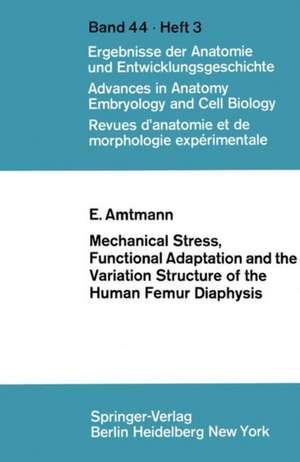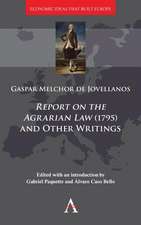Mechanical Stress, Functional Adaptation and the Variation Structure of the Human Femur Diaphysis: Advances in Anatomy, Embryology and Cell Biology, cartea 44/3
Autor E. Amtmannen Limba Engleză Paperback – 1971
Din seria Advances in Anatomy, Embryology and Cell Biology
- 5%
 Preț: 1146.33 lei
Preț: 1146.33 lei - 5%
 Preț: 721.19 lei
Preț: 721.19 lei - 15%
 Preț: 637.13 lei
Preț: 637.13 lei -
 Preț: 381.81 lei
Preț: 381.81 lei - 15%
 Preț: 644.95 lei
Preț: 644.95 lei - 5%
 Preț: 1025.16 lei
Preț: 1025.16 lei - 15%
 Preț: 689.97 lei
Preț: 689.97 lei - 15%
 Preț: 577.07 lei
Preț: 577.07 lei - 15%
 Preț: 580.36 lei
Preț: 580.36 lei - 5%
 Preț: 393.51 lei
Preț: 393.51 lei -
 Preț: 408.66 lei
Preț: 408.66 lei -
![Die Schlüpfdrüse der Geburtshelferkröte (Alytes o. obstetricans [LAURENTI]) und anderer Froschlurche](https://i4.books-express.ro/bs/9783662239742/die-schluepfdruese-der-geburtshelferkroete-alytes-o-obstetricans-laurenti-und-anderer-froschlurche.jpg) Preț: 408.27 lei
Preț: 408.27 lei - 5%
 Preț: 1090.61 lei
Preț: 1090.61 lei - 5%
 Preț: 705.11 lei
Preț: 705.11 lei - 5%
 Preț: 706.04 lei
Preț: 706.04 lei - 5%
 Preț: 357.61 lei
Preț: 357.61 lei - 5%
 Preț: 704.59 lei
Preț: 704.59 lei - 5%
 Preț: 705.11 lei
Preț: 705.11 lei - 5%
 Preț: 359.42 lei
Preț: 359.42 lei - 5%
 Preț: 711.52 lei
Preț: 711.52 lei - 15%
 Preț: 635.47 lei
Preț: 635.47 lei - 15%
 Preț: 631.72 lei
Preț: 631.72 lei - 15%
 Preț: 633.35 lei
Preț: 633.35 lei - 15%
 Preț: 632.37 lei
Preț: 632.37 lei - 5%
 Preț: 706.60 lei
Preț: 706.60 lei - 15%
 Preț: 631.07 lei
Preț: 631.07 lei - 5%
 Preț: 707.13 lei
Preț: 707.13 lei - 5%
 Preț: 707.33 lei
Preț: 707.33 lei - 5%
 Preț: 359.60 lei
Preț: 359.60 lei - 5%
 Preț: 707.69 lei
Preț: 707.69 lei - 5%
 Preț: 707.13 lei
Preț: 707.13 lei - 5%
 Preț: 708.06 lei
Preț: 708.06 lei - 5%
 Preț: 706.41 lei
Preț: 706.41 lei - 5%
 Preț: 708.78 lei
Preț: 708.78 lei - 5%
 Preț: 705.68 lei
Preț: 705.68 lei - 5%
 Preț: 705.11 lei
Preț: 705.11 lei - 5%
 Preț: 706.77 lei
Preț: 706.77 lei - 15%
 Preț: 635.15 lei
Preț: 635.15 lei - 15%
 Preț: 631.07 lei
Preț: 631.07 lei - 5%
 Preț: 706.77 lei
Preț: 706.77 lei - 5%
 Preț: 706.04 lei
Preț: 706.04 lei - 5%
 Preț: 710.79 lei
Preț: 710.79 lei - 5%
 Preț: 705.32 lei
Preț: 705.32 lei - 15%
 Preț: 633.19 lei
Preț: 633.19 lei - 15%
 Preț: 629.09 lei
Preț: 629.09 lei - 15%
 Preț: 633.53 lei
Preț: 633.53 lei - 15%
 Preț: 632.70 lei
Preț: 632.70 lei - 15%
 Preț: 633.68 lei
Preț: 633.68 lei - 18%
 Preț: 773.72 lei
Preț: 773.72 lei - 15%
 Preț: 630.43 lei
Preț: 630.43 lei
Preț: 705.32 lei
Preț vechi: 742.43 lei
-5% Nou
Puncte Express: 1058
Preț estimativ în valută:
134.96€ • 141.31$ • 111.94£
134.96€ • 141.31$ • 111.94£
Carte tipărită la comandă
Livrare economică 10-24 aprilie
Preluare comenzi: 021 569.72.76
Specificații
ISBN-13: 9783540054641
ISBN-10: 3540054642
Pagini: 92
Ilustrații: 90 p. 2 illus.
Dimensiuni: 170 x 244 x 5 mm
Greutate: 0.16 kg
Ediția:Softcover reprint of the original 1st ed. 1971
Editura: Springer Berlin, Heidelberg
Colecția Springer
Seria Advances in Anatomy, Embryology and Cell Biology
Locul publicării:Berlin, Heidelberg, Germany
ISBN-10: 3540054642
Pagini: 92
Ilustrații: 90 p. 2 illus.
Dimensiuni: 170 x 244 x 5 mm
Greutate: 0.16 kg
Ediția:Softcover reprint of the original 1st ed. 1971
Editura: Springer Berlin, Heidelberg
Colecția Springer
Seria Advances in Anatomy, Embryology and Cell Biology
Locul publicării:Berlin, Heidelberg, Germany
Public țintă
ResearchCuprins
A. Introduction.- 1. The Formation of the Normal Femur Shape.- 2. The Functional Structure of the Femur Corticalis.- 3. Forces Acting on Human Femur Cross-sections.- 4. The Aim of the Present Investigation.- B. Materials and Methods.- C. Results.- 1. The Variation in Density of the Femur Shaft.- 2. The Variation of Breaking Strength in the Femur Shaft.- 3. The Variation of Structure Strength in the Shaft.- 4. Cross-sectional Area and Shape.- 5. Thickness of Compacta and Breaking Strength.- 6. Factor Analysis of the Variation Structure of Human Femur Cross-sections.- D. Discussion.- 1. The Problem of Lack of Bone Resorption in the Vicinity of the Neutral Surface.- 2. The Adaptation of Femur Cross-sections to Fluctuating Bending Stresses on the Assumption that Bone is an Isotropic Material.- 3. The Adaptation of the Femur Compacta to Fluctuating Bending Stresses by Means of Specific Distribution of Anisotropic Bone Material.- 4. The Factors Affecting the Variation of Size, Shape, and Structure of the Femur Diaphysis.- Summary.- Zusammenfassung.- Subject-Index.







